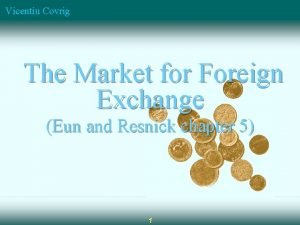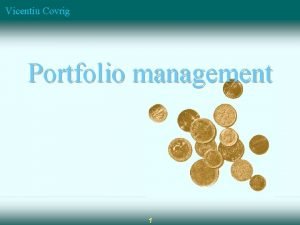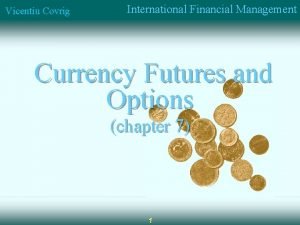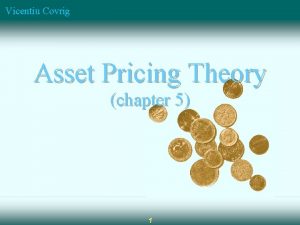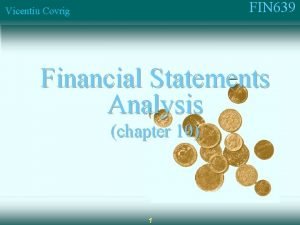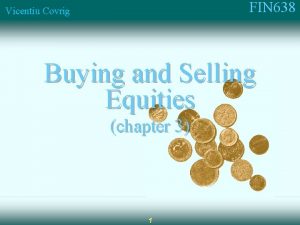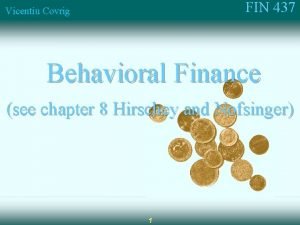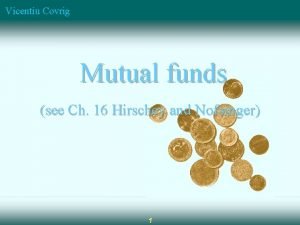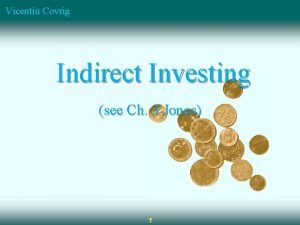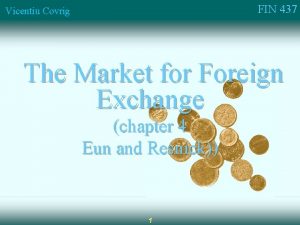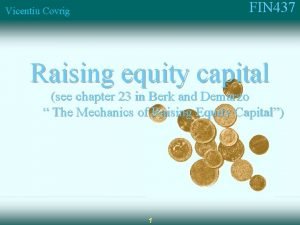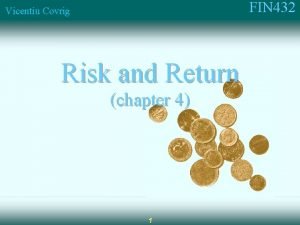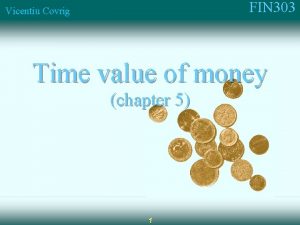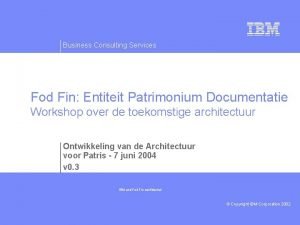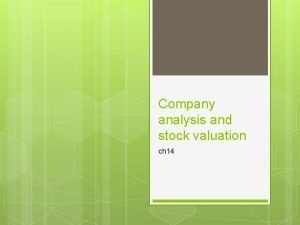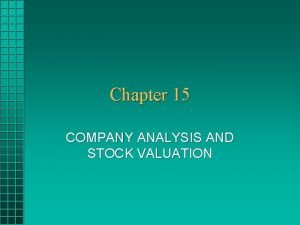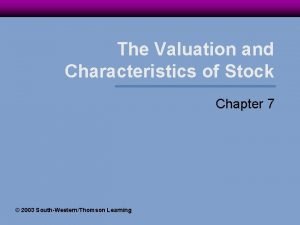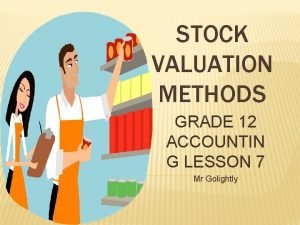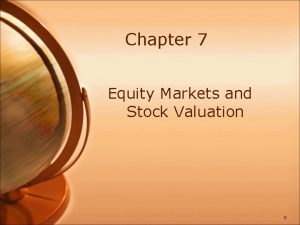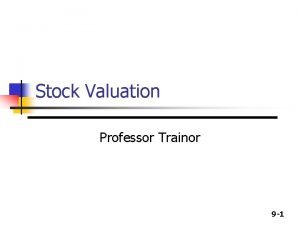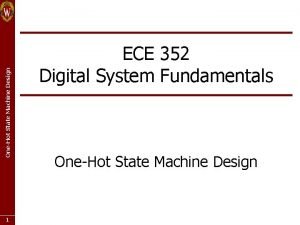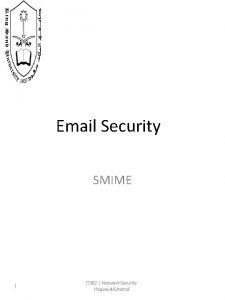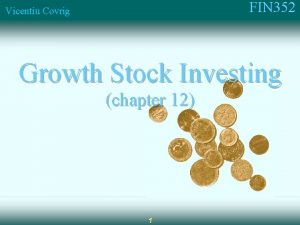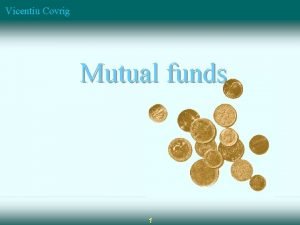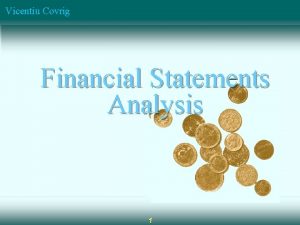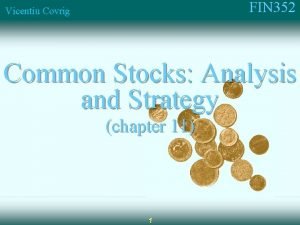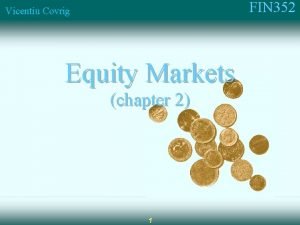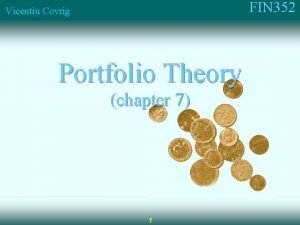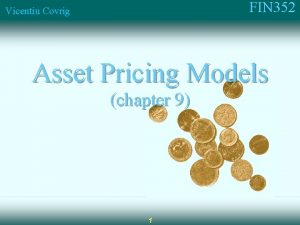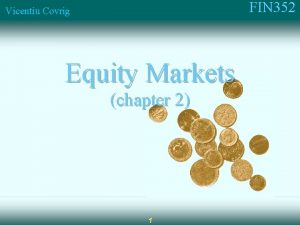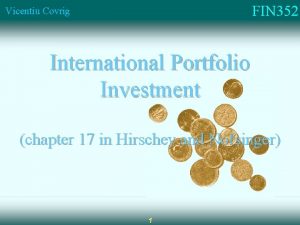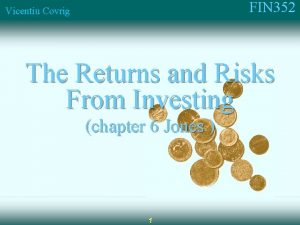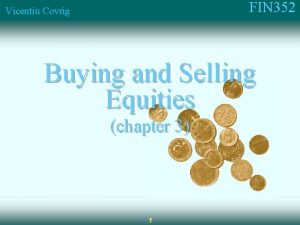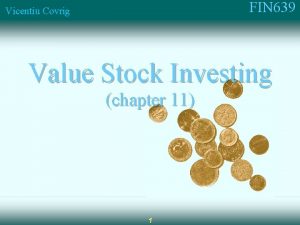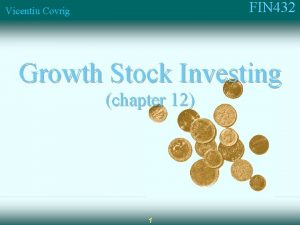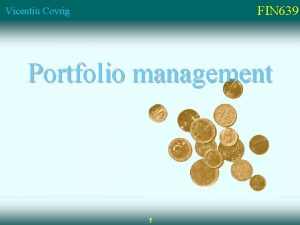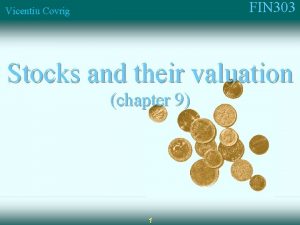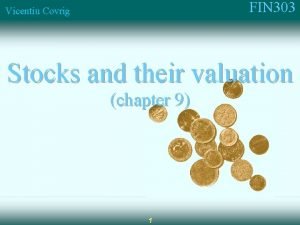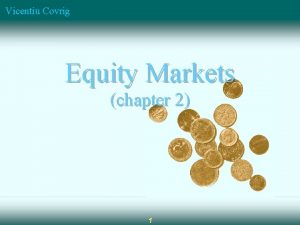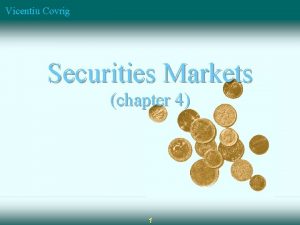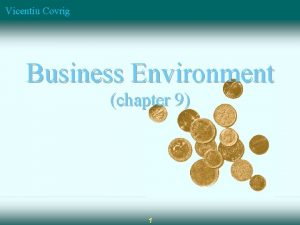FIN 352 Vicentiu Covrig Common Stock Valuation chapter




























- Slides: 28

FIN 352 Vicentiu Covrig Common Stock Valuation (chapter 10) 1

FIN 352 Vicentiu Covrig Fundamental Analysis n Present value approach - Capitalization of expected income - Intrinsic value based on the discounted value of the expected stream of cash flows n Multiple of earnings approach - Valuation relative to a financial performance - measure Justified P/E ratio 2

FIN 352 Vicentiu Covrig Present Value Approach n Intrinsic value of a security is n Estimated intrinsic value compared to the current market price - What if market price is different than estimated intrinsic value? - If Market Price < Intrinsic Value => BUY - If Market Price > Intrinsic Value => SELL 3

FIN 352 Vicentiu Covrig Required Inputs n Expected cash flows: - Size - Timing - Measurement n Discount rate - Required rate of return: minimum expected rate to - induce purchase The opportunity cost of dollars used for investment 4

FIN 352 Vicentiu Covrig Dividend Discount Model n Current value of a share of stock is the discounted value of all future dividends 5

FIN 352 Vicentiu Covrig Dividend Discount Model n n n Appropriate for value firms with stable dividend payments The constant growth rate model Growth firms are often difficult to value because of the fast and variable growth rates. - So, return to the more general dividend discount model: 6

FIN 352 Vicentiu Covrig Constant growth stock n A stock whose dividends are expected to grow forever at a constant rate, g. D 1 = D 0 (1+g)1 D 2 = D 0 (1+g)2 Dt = D 0 (1+g)t n If g is constant, the dividend growth formula converges to: 7

FIN 352 Vicentiu Covrig What happens if g > rs? If g > k, the constant growth formula leads to a negative stock price, which does not make sense. n The constant growth model can only be used if: n - k> g - g is expected to be constant forever 8

FIN 352 Vicentiu Covrig If r. RF = 7%, r. M = 12%, and β = 1. 2, what is the required rate of return on the firm’s stock? n Use the SML to calculate the required rate of return (k): k = r. RF + (r. M – r. RF)β = 7% + (12% - 7%)1. 2 = 13% 9

FIN 352 Vicentiu Covrig If D 0 = $2 and g is a constant 6%, What is the stock’s market value? n Using the constant growth model: 10

FIN 352 Vicentiu Covrig What would the expected price today be, if g = 0? n The dividend stream would be a perpetuity. 11

FIN 352 Vicentiu Covrig Dividend Discount Model n Implications of constant growth - Stock prices grow at the same rate as the dividends - Stock total returns grow at the required rate of return u. Dividend yield plus growth rate in dividends equals k, the required rate of return - A lower required return or a higher expected growth in dividends raises prices 12

FIN 352 Vicentiu Covrig Dividend Discount Model n Multiple growth rates: two or more expected growth rates in dividends - Ultimately, growth rate must equal that of the - economy as a whole Assume growth at a rapid rate for n periods followed by steady growth 13

FIN 352 Vicentiu Covrig Dividend Discount Model n Multiple growth rates - First present value covers the period of super- normal (or sub-normal) growth Second present value covers the period of stable growth u. Expected price uses constant-growth model as of the end of super- (sub-) normal period u. Value at n must be discounted to time period zero 14

FIN 352 Vicentiu Covrig Supernormal growth: What if g = 30% for 3 years before achieving long-run growth of 6%? n n Can no longer use just the constant growth model to find stock value. However, the growth does become constant after 3 years. 15

FIN 352 Vicentiu Covrig Valuing common stock with nonconstant growth 0 k = 13% 1 gs = 30% D 0 = 2. 00 2 gs = 30% 2. 6 3 gs = 30% 3. 380 4 . . . gc = 6% 4. 394 4. 658 2. 6/(1+0. 13) = 2. 301 2. 647 3. 045 66. 54/(1+0. 13)^3 = 46. 114 54. 107 P$ 3 = ^ = P 0 16 4. 658 0. 13 - 0. 06 = $66. 54

FIN 352 Vicentiu Covrig Calculations: D 1 = D 0*(1+g 1)= 2 x(1+0. 3)= 2. 6 D 2 = D 1*(1+g 1)= 2. 6 x(1+0. 3)= 3. 38 D 3 = D 2*(1+g 1)= 3. 38 x(1+0. 3)= 4. 394 D 4 = D 3*(1+g 2)= 4. 394 x(1+0. 06) = 4. 658 Present Value of D 1= 2. 6/(1+0. 13) = 2. 301 Present Value of D 2= 3. 38/(1+0. 13)^2 = 2. 647 Present Value of D 3= 4. 394/(1+0. 13)^3 = 3. 045 17

FIN 352 Vicentiu Covrig What about Capital Gains? n DDM accounts for capital gains - Future price reflects expected dividends from that - n point forward DDM assumes price appreciates at “g” Valuing only dividends or a combination of dividends and price produces same result Rearranging DDM shows two components of expected return: 18

FIN 352 Vicentiu Covrig Other Discounted Cash Flows n Free Cash Flow to Equity (FCFE): What could shareholders be paid? - FCFE = Net Inc. + Depreciation – Change in Noncash Working Capital – Capital Expend. – Debt Repayments + Debt Issuance n Free Cash Flow to the Firm (FCFF): What cash is available before any financing considerations? - FCFF = EBIT (1 -tax rate) + Depreciation – Change in Noncash Working Capital – Capital Expend. n Use per share measures instead of dividends 19

FIN 352 Vicentiu Covrig Other Discounted Cash Flow Approaches: Corporate value model n Also called the free cash flow method. Suggests the value of the entire firm equals the present value of the firm’s free cash flows. 1. Find the market value (MV) of the firm. - Find PV of firm’s future FCFs 2. Subtract MV of firm’s debt and preferred stock to get MV of common stock. MV of = MV of – MV of debt and common stock firm preferred 3. Divide MV of common stock by the number of shares outstanding to get intrinsic stock price (value). - P 0 = MV of common stock / # of shares 20

FIN 352 Vicentiu Covrig Intrinsic Value n “Fair” value based on the capitalization of income process - The objective of fundamental analysis n If intrinsic value >(<) current market price, hold or purchase (avoid or sell) because the asset is undervalued (overvalued) - Decision will always involve estimates 21

FIN 352 Vicentiu Covrig P/E Ratio or Earnings Multiplier Approach Alternative approach often used by security analysts n P/E ratio is the strength with which investors value earnings as expressed in stock price n - Divide the current market price of the stock by the - latest 12 -month earnings Price paid for each $1 of earnings 22

FIN 352 Vicentiu Covrig Multiplier Approach for Valuation n Alternative to discounted cash flow approach n Widely used approach due to ease of interpretation and calculation n Value estimate is the product of two inputs 1. Firm financial characteristic 2. Estimated price multiple (multiplier) 23

FIN 352 1 Vicentiu Covrig 0 P/E Multiplier Approach 2 n To estimate a stock’s value (V ), an analyst 0 4 must forecast next period’s EPS (E ) and the 1 appropriate current multiplier for next period’s estimated EPS (P 0/E 1)A 24

FIN 352 Vicentiu Covrig Multiplier Approach for Valuation n Used with a variety of price multiples - P/S, P/B, P/CF, EV/EBITDA n P/E multiple (ratio) is the most commonly considered multiplier - Reflects price paid for each $1 of earnings n Approach is also used to value other asset types - Commonly applied to real estate 25

FIN 352 Vicentiu Covrig Relative Valuation n Compare firm to peers, or the market, to assess relative valuation n Most applicable when comparison is between similar type firms n Apply the same multiples as used in the multiplier approach - P/E, P/B, P/S, P/CF and EV/EBITDA n P/E ratios tend to be emphasized 26

FIN 352 1 Vicentiu Covrig 0 Which Approach Is Best? 2 n Discounted cash flow is theoretically best 7 - Application is difficult in some cases n Price multiples serve dual role - Estimating intrinsic value of stock - Relative valuation n n All methods subject to estimation error Traditional methods apply to “new economy” stocks: revenues and profits matter 27

FIN 352 Vicentiu Covrig Learning objectives Know the Dividend Discount Model Know the Constant Growth Model Know the Discounted model with two growth rates Know the discounted cash flow approach Know the P/E and multiplier approaches Relative valuation metrics End of chapter questions 10. 1 to 10. 5, 10. 14; All four demonstration problems; Problems 10. 1 to 10. 4 28
 Vicentiu covrig
Vicentiu covrig Vicentiu covrig
Vicentiu covrig Vicentiu covrig
Vicentiu covrig Covrig,vicentiu m
Covrig,vicentiu m Covrig,vicentiu m
Covrig,vicentiu m Vicentiu covrig
Vicentiu covrig Vicentiu covrig
Vicentiu covrig Vicentiu covrig
Vicentiu covrig Vicentiu covrig
Vicentiu covrig Vicentiu covrig
Vicentiu covrig Vicentiu covrig
Vicentiu covrig Vicentiu covrig
Vicentiu covrig Vicentiu covrig
Vicentiu covrig Fin 303
Fin 303 Common stock valuation
Common stock valuation Features of preferred stock
Features of preferred stock Characteristics of common shares
Characteristics of common shares Spf fin fod fin
Spf fin fod fin Prisme à base trapézoidale
Prisme à base trapézoidale Valuation of fixed income securities or valuation of bonds
Valuation of fixed income securities or valuation of bonds Company analysis
Company analysis Avco stock valuation
Avco stock valuation Company analysis stock valuation
Company analysis stock valuation Characteristics of stock valuation
Characteristics of stock valuation Accounti g
Accounti g Equity markets and stock valuation
Equity markets and stock valuation Preferred stock valuation
Preferred stock valuation One hot state assignment
One hot state assignment It 352
It 352
